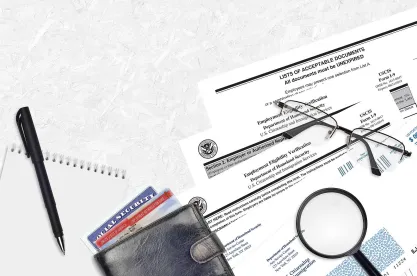The United States Department of Homeland Security (DHS) recently announced two significant changes regarding Form I-9, Employment Eligibility Verification. First, DHS is issuing a new version of Form I-9. Second, as of August 1, 2023, DHS will allow qualified E-Verify employers to use an alternative document inspection procedure when completing § 2 or § 3 of Form I-9. Under this alternative procedure, E-Verify employers may complete document verification remotely instead of physically examining the original document(s) during an in-person meeting with the new hire (or existing employee during reverification).
New Version of Form I-9
Over more than three decades, employers have grappled with fourteen different versions of Form I-9. In our October 2022 post, we explained that DHS was preparing yet another version of this complicated government form. DHS now is ready to publish the new Form I-9 and will do so on August 1, 2023.
The new Form I-9 contains several major changes:
- ·§ 1 and § 2 are on the same page with more narrow fields in which to write answers to the government’s questions when using the paper version of Form I-9.
- The Preparer/Translator paragraph is no longer part of § 1, but instead is a separate supplement (Supplement A). Employers must provide Supplement A when the new hire requires assistance to complete § 1.
- New hires and employers are no longer required to enter “N/A” in fields that do not apply. Employers were previously subject to fines for failing to ensure “N/A” was entered.
- ·§ 2 contains a new checkbox in the Additional Information field for employers to mark if they have examined documents using an authorized alternative procedure such as the new remote document verification.
- ·§ 3 (for reverification or, in limited circumstances, rehire) no longer follows § 2. Instead, § 3 is a separate supplement (Supplement B).
- The I-9 List of Acceptable Documents now includes
- a summary of when certain, valid receipts may be accepted for documents listed under List A, List B, or List C; and
- a statement that DHS will consider documents that are extended by the issuing authority (e.g., a state department of motor vehicles) to be unexpired.
- The new I-9 instructions are eight pages rather than fifteen pages. DHS has moved some of the deleted content to its Handbook for Employers and I-9 Central website.
DHS is allowing employers three months to transition to the new version of Form I-9. Thus, employers may lawfully continue to use the existing version of Form I-9 (issuance date of October 21, 2019) through the end of business on October 31, 2023. By November 1, 2023, all employers must use the new version of Form I-9 for new hires and reverifications.
Best Practice Tip: Employers should use the transition period (August 1, 2023, through October 31, 2023) to review and become familiar with the new version of Form I-9 as well as the new I-9 instructions. Switching to the new version too quickly will increase the likelihood of errors, which, in turn, may lead to higher government fines.
New Remote Document Verification Procedure an Option for E-Verify Employers in Good Standing
DHS has established a new I-9 remote document verification procedure as an alternative to in-person physical document examination. Employers that wish to use remote document verification must be enrolled in the E-Verify program and be in “good standing” at the time that they rely on the new procedure. This alternative procedure is available as of August 1, 2023.
Under the new I-9 remote document verification procedure, qualified E-Verify employers must take the following steps:
- Ask the new hire to review the I-9 List of Acceptable Documents and select a valid List A document OR valid List B document and valid List C document of their choice. For reverification, provide the I-9 List and ask the existing employee to present a valid List A document OR valid List C document to confirm continued employment eligibility.
- After the employee selects the document(s), ask the employee to send to the employer “clear and legible” copies of the document(s). If a document is two-sided, the new hire (or existing employee) must provide the employer with copies of the front and back of the document.
- Review the clear and legible copies of the document(s) to confirm that they reasonably appear genuine.
- After receiving and reviewing the document(s), conduct a video meeting with the new hire (or existing employee if on reverification). During this video meeting, ask the new hire (or existing employee) to show the original document(s) for which copies were transmitted earlier. Compare the document(s) presented during the video meeting to the person on the video screen and to the information stated in § 1 of Form I-9. Confirm that the document(s) reasonably appear genuine. If the new hire or existing employee is relying on a valid receipt for a document on the I-9 List, review the receipt during the video meeting.
- Mark the checkbox in the Additional Information field of § 2 to show that the employer used the remote document verification procedure. If the employer is still using the existing Form I-9 (issuance date of October 21, 2019), write “Alternative Procedure” in the Additional Information Field.
- Timely open the E-Verify case inquiry following completion of Form I-9. Under current law, E-Verify employers are required to open an E-Verify case inquiry by the end of the third business day after hire. Employers should not open E-Verify inquiries when reverifying Form I-9.
- Retain the clear and legible copies of the document(s) with the completed Form I-9. Produce the Form I-9 and the copies to the government during an I-9 inspection or enforcement action.
- Participate in the training offered by the E-Verify program. This training includes fraud awareness, anti-discrimination rules, and periodic training updates.
E-Verify employers are not required to use the I-9 remote document verification procedure. If E-Verify employers choose to use this new procedure, they may do so for all employees or for only those Forms I-9 associated with employees who are working remotely. Employers must apply I-9 procedures fairly and consistently. Therefore, employers should not require certain remote employees to appear in-person at the company’s offices to complete the I-9 process while allowing other remote employees to complete the I-9 process using the new remote verification procedure.
Best Practice Tip: Employers should follow the traditional in-person, physical document inspection procedure for employees who report to the employers’ facility and use the new alternative procedure only for employees who work remotely. To protect the integrity and security of the I-9 system, DHS will carefully monitor employers’ use of the new alternative procedure. Even with the heightened government monitoring, the remote document procedure is a much better choice for employers than hiring a local third-party agent. With remote document verification, employers have a better opportunity to achieve I-9 compliance.




 />i
/>i
